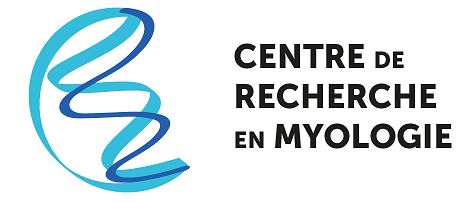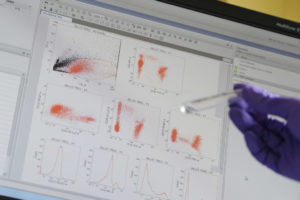France Piétri-Rouxel
Research Director, team leader
Titles and positions
- Research Director DR2 CNRS
- HDR Sorbonne University
Expertises
Molecular and cellular biology, molecular pharmacology, gene therapy (AAV vectors, overexpression and suppression of genes), pathophysiology of skeletal muscle and in particular Duchenne Muscular Dystrophy (DMD), experimental models of genetic diseases.
Presentation
My thesis work at the University of Paris Sud Orsay allowed me to determine the properties and to discover the regulatory mechanisms of the InsP3 receptor in hepatocytes. During my postdoctoral training, I performed the pharmacological characterization and the study of the ligand-receptor interaction of the human beta3-adrenergic receptor, thus opening new avenues for the development of molecules with anti-obesity therapeutic targets (1 patent). My project as a research fellow at the CNRS focused on the understanding of the mechanisms related to the appearance of lipodystrophy, an iatrogenic effect induced by HIV antiretroviral treatment. My research then focused on the pathophysiology of dystrophinopathies by developing approaches ranging from basic research to the development of preclinical tools based on gene therapy (2 patents).
Today, as Director of Research at the CNRS, I lead the DMD gene therapy and skeletal muscle pathophysiology team within the Myology Research Center. The main axes of the project are (i) optimizing strategies for DMD with combined therapies and (ii) understanding the mechanisms governing the maintenance of muscle mass, particularly in the case of altered connectivity with the motor neuron, but also in the broader context of aging, sarcopenia.
Main publications
- Mollard, A, Peccate, C, Forand, A, Chassagne, J, Julien, L, Meunier, P et al.. Muscle regeneration affects Adeno Associated Virus 1 mediated transgene transcription. Sci Rep. 2022;12 (1):9674. doi: 10.1038/s41598-022-13405-9. PubMed PMID:35690627 PubMed Central PMC9188557.
- Taglietti, V, Kefi, K, Bronisz-Budzyńska, I, Mirciloglu, B, Rodrigues, M, Cardone, N et al.. Duchenne muscular dystrophy trajectory in R-DMDdel52 preclinical rat model identifies COMP as biomarker of fibrosis. Acta Neuropathol Commun. 2022;10 (1):60. doi: 10.1186/s40478-022-01355-2. PubMed PMID:35468843 PubMed Central PMC9036715.
- Vergnol, A, Traoré, M, Pietri-Rouxel, F, Falcone, S. New Insights in CaVβ Subunits: Role in the Regulation of Gene Expression and Cellular Homeostasis. Front Cell Dev Biol. 2022;10 :880441. doi: 10.3389/fcell.2022.880441. PubMed PMID:35465309 PubMed Central PMC9019481.
- Gargaun, E, Falcone, S, Solé, G, Durigneux, J, Urtizberea, A, Cuisset, JM et al.. The lncRNA 44s2 Study Applicability to the Design of 45-55 Exon Skipping Therapeutic Strategy for DMD. Biomedicines. 2021;9 (2):. doi: 10.3390/biomedicines9020219. PubMed PMID:33672764 PubMed Central PMC7924625.
- Forand, A, Muchir, A, Mougenot, N, Sevoz-Couche, C, Peccate, C, Lemaitre, M et al.. Combined Treatment with Peptide-Conjugated Phosphorodiamidate Morpholino Oligomer-PPMO and AAV-U7 Rescues the Severe DMD Phenotype in Mice. Mol Ther Methods Clin Dev. 2020;17 :695-708. doi: 10.1016/j.omtm.2020.03.011. PubMed PMID:32346547 PubMed Central PMC7177166.
- Traoré, M, Gentil, C, Benedetto, C, Hogrel, JY, De la Grange, P, Cadot, B et al.. An embryonic CaVβ1 isoform promotes muscle mass maintenance via GDF5 signaling in adult mouse. Sci Transl Med. 2019;11 (517):. doi: 10.1126/scitranslmed.aaw1131. PubMed PMID:31694926 .
- Guilbaud, M, Gentil, C, Peccate, C, Gargaun, E, Holtzmann, I, Gruszczynski, C et al.. miR-708-5p and miR-34c-5p are involved in nNOS regulation in dystrophic context. Skelet Muscle. 2018;8 (1):15. doi: 10.1186/s13395-018-0161-2. PubMed PMID:29703249 PubMed Central PMC5924477.
- Delalande, O, Molza, AE, Dos Santos Morais, R, Chéron, A, Pollet, É, Raguenes-Nicol, C et al.. Dystrophin's central domain forms a complex filament that becomes disorganized by in-frame deletions. J Biol Chem. 2018;293 (18):6637-6646. doi: 10.1074/jbc.M117.809798. PubMed PMID:29535188 PubMed Central PMC5936807.
- Julien, L, Chassagne, J, Peccate, C, Lorain, S, Piétri-Rouxel, F, Danos, O et al.. RFX1 and RFX3 Transcription Factors Interact with the D Sequence of Adeno-Associated Virus Inverted Terminal Repeat and Regulate AAV Transduction. Sci Rep. 2018;8 (1):210. doi: 10.1038/s41598-017-18604-3. PubMed PMID:29317724 PubMed Central PMC5760533.
- Godfrey, C, Desviat, LR, Smedsrød, B, Piétri-Rouxel, F, Denti, MA, Disterer, P et al.. Delivery is key: lessons learnt from developing splice-switching antisense therapies. EMBO Mol Med. 2017;9 (5):545-557. doi: 10.15252/emmm.201607199. PubMed PMID:28289078 PubMed Central PMC5412803.
- Rendu, J, Montjean, R, Coutton, C, Suri, M, Chicanne, G, Petiot, A et al.. Functional Characterization and Rescue of a Deep Intronic Mutation in OCRL Gene Responsible for Lowe Syndrome. Hum Mutat. 2017;38 (2):152-159. doi: 10.1002/humu.23139. PubMed PMID:27790796 .
- Peccate, C, Mollard, A, Le Hir, M, Julien, L, McClorey, G, Jarmin, S et al.. Antisense pre-treatment increases gene therapy efficacy in dystrophic muscles. Hum Mol Genet. 2016;25 (16):3555-3563. doi: 10.1093/hmg/ddw201. PubMed PMID:27378686 .
- Gentil, C, Le Guiner, C, Falcone, S, Hogrel, JY, Peccate, C, Lorain, S et al.. Dystrophin Threshold Level Necessary for Normalization of Neuronal Nitric Oxide Synthase, Inducible Nitric Oxide Synthase, and Ryanodine Receptor-Calcium Release Channel Type 1 Nitrosylation in Golden Retriever Muscular Dystrophy Dystrophinopathy. Hum Gene Ther. 2016;27 (9):712-26. doi: 10.1089/hum.2016.041. PubMed PMID:27279388 .




